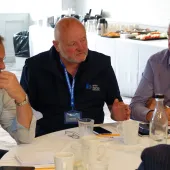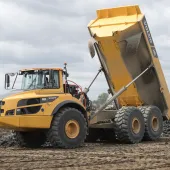British Aggregates Association’s 2014 Conference Report

First published in the August 2014 issue of Quarry Management as Something for Everyone
The British Aggregates Association’s 2014 conference proceedings
As is the norm in a Hillhead exhibition year, the 2014 conference of the British Aggregates Association (BAA) took place at the Palace Hotel, in Buxton, Derbyshire, on Monday 23 June, the day before the show opened for business. Chaired as usual by BAA secretary Peter Huxtable and with no fewer than 12 guest speakers, the conference seminar covered a broad range of themes that gave the 100 or so registered delegates much to think about and discuss during the course of the day.
The proceedings began with the now customary morning session comprising six short ‘cameo’ presentations. This was opened by James Spencer, founder of The Fuel Trading Company (Portland Fuels), a specialist oil trading company that aims to assist SMEs whose operations are affected by movements in oil price. Emphasizing the difficulty in predicting which way oil prices are likely to go, he outlined various global factors that can drive oil prices up, such as economic recovery, rising consumption/demand, tensions in oil-producing regions etc, and others that can drive prices down, such as the creation of buffer stocks and the rapid growth in shale oil production. He added that economic policy could have a big impact on oil prices but said it was very difficult to predict whether this would exert upward or downward pressure. According to James, the only major factor certain to force oil prices down in the future is the US shale oil revolution. In conclusion, he urged any operators worried about fuel price fluctuations and uncertainty to think about ‘fixing’ the cost of their fuel.
Staying with the energy theme, John Leeson of SLR Consulting looked at the solar PV energy options for the quarrying and minerals industry. Against a background of rising gas and electricity prices, he said the future was bright for solar PV energy with the Government looking to increase installed capacity from 2.5GW currently to 10GW by 2020. He explained how a typical 1,000m2 solar roof array could generate 100MW of electricity over a 12-month period and said quarries often lend themselves well to this scale of development. John also explained how, under Part 2 of its solar strategy, the Government intends to withdraw Renewable Obligation Certificates (ROC) support to solar PV schemes over 5MW in April 2015 but will maintain Feed in Tariff (FiT) support for schemes less than 5MW. However, he warned that the starting tariff per kWh will continue to reduce in future and urged quarry operators thinking of diversifying their energy supply with solar PV to do so sooner rather than later.
Next to speak was Anthony Elgey, manager of MP-Futures, who explained how the current apprenticeship frameworks will be completely phased out in England by 2017/18, to be replaced by employer-led Trailblazers. The minerals products sector will be part of phase 3 of the Trailblazer programme, which starts next month. Anthony said participation in the programme would help elevate the sector’s image and profile, providing the opportunity to lead and not follow other sectors’ output. Commenting briefly on new developments in training, eg mobile plant simulators, he said MP-Futures would be assessing the benefits of such equipment to the sector. Anthony concluded by explaining how partnering with the British Science Association (BSA) and developing projects under its Crest Awards scheme for schoolchildren was key to engaging future generations.
Scott Dugan of Command Alkon was next to take the floor with a presentation on best practice in vehicle entry/check-in, loading and exit/ticketing, based on experiences from around the world. He outlined some of the integrated technology currently available, including RFID, CCTV, driver terminals/kiosks, message boards, ruggedized tablets in loaders, barriers, traffic lights, remote ticket printing etc, and pointed out that this sort of technology can be beneficial to operations of all sizes, not just large sites.
An update on respirable crystalline silica (RCS) was provided by Andy Price, strategic health and safety manager for Sibelco Europe. He explained why RCS is not a typical carcinogen and does not fit neatly within the EU legal framework. Member states have differing opinions on the potential regulatory scenario so the European Commission may eventually make the final decision. Andy said the most likely approach would be product classification and labels based on the classification of RCS as STOT RE1, with worker protection regulated with a binding limit value (BLV) under the Carcinogens and Mutagens Directive (CMD). He added the possible merging of the Chemical Agents Directive and the CMD could be a positive move, and said the industry still had time to influence a pragmatic outcome.
In the final cameo presentation of the morning, HSE Quarry Inspector Cath Pickett provided a review of the first year of the BAA and HSE’s ‘working together’ initiative. She explained how a total of 29 BAA sites had been visited during the 12-month trial period, including volunteer sites, sites within the BAA’s operating standards scheme and sites not in the scheme. The inspections revealed a variety of health and safety issues but inadequate machinery guarding proved to be the most common infringement. Summing up, Cath said the volunteer sites were usually good, those ‘in scheme’ were usually trying hard, and those ‘out of scheme’ were either not trying at all or already had a proactive attitude and a well-developed management system in place. From the HSE’s perspective, she said the trial had been worthwhile, adding that if the BAA plans to continue the initiative, more volunteers and better publicity among members and at site level would be beneficial.
The morning session concluded with the BAA’s Assessment of Operating Standards ceremony, at which Eric Darlow, chair of the BAA’s Standards and Awards Panel, presented certificates to Colin Morrow of Barr Quarries for Tincornhill Quarry; Roger Cullimore of Moreton C. Cullimore (Gravels) Ltd for Roundhouse Farm Quarry; Mike Lowe of Summerleaze Ltd for Bray Quarry and Denham Quarry; and Barry Wilson of E&JW Glendinning for Pigsdon Quarry and Linhay Hill Quarry. In his speech, Eric congratulated all the winners, particularly those who achieved their three-year reassessment, and said the Awards Committee was pleased to report that more than half of BAA quarrying members were now participating in the scheme. Eric also took the opportunity to announce that, after several years as chair of the Awards Panel, he would be stepping down from the role as soon as a replacement could be found.
After lunch, the afternoon seminar session commenced with a presentation by Ruth Allington, senior partner with GWP Consultants, who spoke about how best to employ professional skills in quarry design and management in order to deliver sustainable development and achieve social license to operate. She outlined the synergies and conflicts that can occur in attempting to deliver commercial objectives and safety and operational efficiency with minimal environmental impact, and highlighted the essential professional skills needed in each area of quarry design and management. Ruth explained that meeting these objectives could be achieved through either a ‘departmental’ approach or a ‘holistic’ approach, her preference being the latter where quarry design forms the central activity. As well as technical, commercial and scientific skills, she spoke of the need for other vital skills or attitudes, such as communication, respect for the views of others and flexibility or openness to change.
The next presentation was a tripartite offering by Julian Smallshaw, head of educational development with the Institute of Quarrying (IQ), Paul Sutton, general manager of IQ Australia, and Mark Osbaldeston, head of the Centre for Mineral Products Professional Development (MPPD) at University of Derby Corporate. Julian began by highlighting developments in the IQ over the last 12 months, including the recent change in governance and the launch of PRIME, TMIQ and the Institute’s new website, before going on to discuss the IQ’s global education strategy, focusing in particular on the huge potential training opportunities in Saudi Arabia, the United Arab Emirates and the Middle East in general.
He added that the National Stone, Sand and Gravel Association (NSSGA) in the US had also expressed interest in the IQ’s education and training offering. Next, Paul Sutton gave a brief insight into the educational and training activities of IQ Australia, including its Professional Development Program (PDP) and long-term aim to establish a national system of certification for practitioners in the quarry industry through the establishment of the Quarry Manager Certification Scheme (QMCS). Finally, Mark Osbaldeston provided an update on the array of qualifications and educational programmes on offer from MPPD, including the recently introduced two-year honours degree in Minerals Management, and soon to be launched Level 5 diplomas in Road Surface Technology and Concrete Studies.
In the penultimate presentation of the afternoon, Paul Wilkinson, head of living landscapes for The Wildlife Trusts, spoke about the role the minerals industry can play in the recovery of nature. He said there was a need to move away from thinking about the environment in terms of constraints and impacts, and instead to think about the opportunities, contributions and long-term legacy that early engagement with the industry could deliver. The Wildlife Trusts has a vision of ‘living landscapes’ across the UK and has been championing a recovery plan for nature since 2006. Paul said wildlife and habitats are recovering from past declines and land use is now better for wildlife, but it is fragmented and could be better. He cited North Cave Wetlands in Yorkshire, Meeth Quarry in Devon, the Nene Valley in Northamptonshire and the Idle Valley in Nottinghamshire as good examples of where the industry and local Wildlife Trusts are working together to create living landscapes. Paul concluded by recommending attainment of The Wildlife Trusts’ Biodiversity Benchmark as a way for operators to gain positive national recognition of their commitment to the environment.
The day’s conference proceedings concluded with a presentation by Julian Clapp of BDS Marketing Research Ltd, who began by outlining current regional and national market trends in aggregates, ready-mixed concrete and asphalt, and said that despite one or two regional variations, overall the market was looking healthy for the next two to three years. Looking further ahead, he said the market should get back to 2007 pre-recession levels in about 10 years’ time, but he warned that rising interest rates, the level of UK debt and the cessation of US quantitative easing, among other factors, could result in some ‘potholes’ along the way. However, these would be offset by large infrastructure schemes, such as HS2, as well as the recovery in the housing and commercial markets. In conclusion, Julian said there was likely to be considerable scope for BAA members to focus on the small-to-medium-sized contracts while the majors’ attention was drawn to the larger infrastructure projects.
- Subscribe to Quarry Management, the monthly journal for the mineral products industry, to read articles before they appear on Agg-Net








